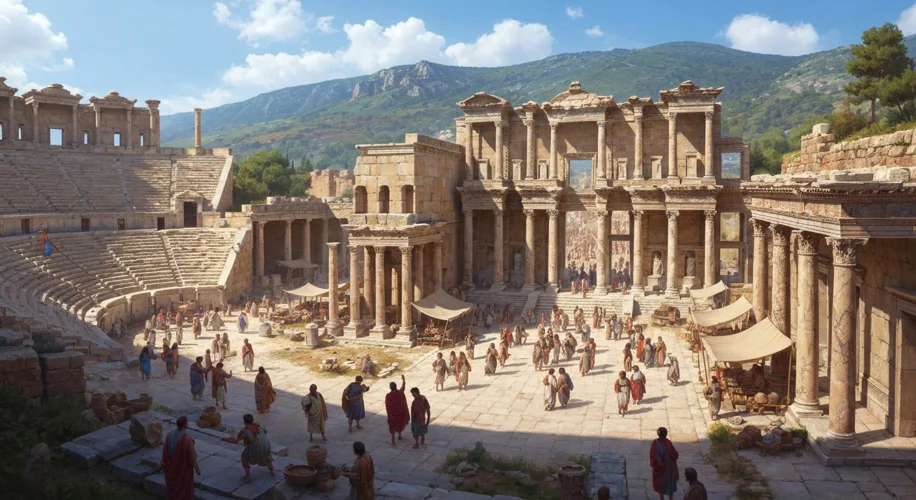Imagine a land where ancient trade routes, still whispering tales of camel caravans, once pulsed with the lifeblood of an empire. Picture cities, their marble bones now weathered by millennia, that stood as vibrant centers of commerce and culture. This was Anatolia, modern-day Turkey, a pivotal region that for centuries served as the very sinews connecting the mighty Roman Empire’s East and West.
For ordinary folks, the Roman presence might conjure images of legionaries marching in disciplined columns or emperors issuing decrees from distant Rome. But in Anatolia, Rome’s influence was far more deeply woven into the fabric of daily life. This vast peninsula, blessed with fertile lands and strategic coastlines, was not merely a conquered territory; it was a vital organ of the Roman body politic, contributing immense wealth, manpower, and strategic depth.
The story of Roman Anatolia isn’t a single, monolithic event, but a centuries-long integration that began long before Rome’s eagles officially landed. The Hellenistic period, following Alexander the Great’s conquests, had already imbued the region with a rich Greek culture and a network of sophisticated cities. When Rome began its expansion eastward, it found a land ripe for assimilation, already accustomed to large-scale administration and a cosmopolitan outlook.
Consider the scale of Roman ambition. They didn’t just conquer; they connected. The legendary Roman roads, engineering marvels that facilitated the swift movement of troops and goods, crisscrossed Anatolia. Imagine the sheer audacity of constructing these arteries of empire, carving paths through rugged mountains and across fertile plains. These roads were more than just infrastructure; they were symbols of Roman power, bringing with them not only military control but also the Roman way of life: law, language, and governance.

The cities of Anatolia blossomed under Roman rule. Ephesus, once a preeminent Greek city, became one of the largest and most important metropolises in the Roman East. Its magnificent library, grand theatre, and bustling harbor were testament to Roman prosperity and patronage. Pergamon, another jewel, boasted a legendary library that rivaled Alexandria’s and a stunning acropolis. Tarsus, the birthplace of St. Paul, was a center of learning and trade. These were not mere outposts, but thriving urban centers where Roman citizens, local elites, and diverse populations interacted, creating a dynamic cultural melting pot.
But what did this Roman presence mean for the people living there? For the wealthy landowners and city elites, Roman rule often meant enhanced opportunities. They could integrate into the Roman administrative system, gain Roman citizenship, and participate in the lucrative trade networks. For the farmers and artisans, life likely continued with familiar rhythms, albeit under a new imperial oversight. Roman law provided a degree of stability, and the Pax Romana, the period of relative peace, allowed commerce to flourish.
However, the Roman presence also brought burdens. Taxation was a constant reality, and the demands of the legions for manpower could be significant. Rebellions, though often brutally suppressed, were a part of the Anatolian experience, as local populations resisted foreign domination. Yet, the story is not simply one of subjugation. Many Anatolians rose to prominence within the Roman system, serving as senators, governors, and even emperors. Figures like Septimius Severus, born in Leptis Magna in North Africa, had roots in a Romanized world that spanned across these very lands.

The impact of Roman Anatolia was profound and far-reaching. It was a crucial breadbasket for the empire, a major source of manpower for its armies, and a conduit for cultural exchange. Greek remained the lingua franca of the East, but Latin and Roman customs gradually infiltrated the region, creating a unique Romano-Hellenistic synthesis. The region’s strategic location also made it a bulwark against eastern threats, particularly the Parthian and later Sasanian empires.
The legacy of Roman Anatolia can still be seen and felt today. The ruins of its cities, its temples, its aqueducts, and, of course, its roads, stand as silent witnesses to Rome’s enduring grip on this land. These remnants are not just stones and mortar; they are echoes of a time when Anatolia was an integral part of a vast empire, a bridge that connected worlds and shaped the course of history.
When we think of Rome, we often envision Italy. But the story of Rome is incomplete without understanding its vast reach, and nowhere is that reach more evident than in the heart of Anatolia, a region that absorbed, adapted, and ultimately helped to sustain one of history’s greatest empires.

